Starting from:
$14.95
Vietnam War: Department of Defense POW/MIA Documents
Vietnam War: Department of Defense POW/MIA Documents
12,379 pages of Department of Defense files dealing with Southeast Asia POW/MIA issues stemming from the Vietnam War. Files date from 1965 to 2019.
Materials Include:
Department of Defense Vietnam War Statistical Reports 3/11/2014 to 2/22/2019
100 pages of reports from the Department of Defense, Washington Headquarters Service, and the Department of State report of the current numbers of Americans who are unaccounted for in Southeast Asia.
Defense Intelligence Agency (DIA) Stony Beach POW & POW Camp Files
2,716 pages of reports. Material dating from 1972 to 1994. The Defense Intelligence Agency (DIA), maintains a team based at Hickham Air Force Base in Hawaii, known as Stony Beach, dedicated solely to support the collection of POW/MIA intelligence, through human intelligence collection operations. Most of this information is gained via interviews throughout Southeast Asia. Stony Beach also performs live sighting investigations in Laos, Vietnam, and Cambodia. Files include: DIA reports from the early 1970's giving analysis, descriptions, locations, diagrams, maps, and handmade drawings concerning various POW camps. Includes DIA data sheets on individuals in Southeast Asia who have provided "live sighting" reports and information on human remains. DIA memorandums covering information obtained from other sources such as the CIA. Communications from the Joint Casualty resolution Center.
Among the many camps in which these files include intelligence on are: Son Tay, Bat Bat Prison, Xom Ap Lo PW Camp, Pho Lu Prison, Reeducation Camp 1 Hoang Lien Son Province, Ha Tay Reeducation Camp, Tra Noc Reeducation Camp, Ha Son Binh, Lai Xa Prison, Dan Hoi Barracks, Yen Bai Camp, Tan Lap Reeducation Camp, Thanh Phong Prison and Quyet Tien Prison.
Laos Prisoner of War Camp Study
A 1,457-page November 1972 Department of the Navy Fleet Intelligence Center Pacific report on the location of prisoner of war camps in Laos. Includes physical descriptions, coordinates of camps, and aerial reconnaissance photos (the mechanical reproductions of photos are minimally discernable).
Prisoners of War in Indochina RM 5729-1-ARPA
A January 1969 report, that was part of continuing Defense Department research into various military and political aspects of the termination of the Vietnam War. It was assumed that in the eventual settlement of the war, the question of the release and exchange of prisoners of war and civilian internees would be of major importance. This study examines issues that needed to be addressed to aid in the formulation of a policy regarding POW return.
Family Conferences - DOD Report of Conferences with Family of POW/MIA Servicemen
1,184 pages of reports of conferences with 269 family members of POW/MIA serviceman. Reports includes summary of information about each case provided to the family.
Barron 52 - Peters R. Cressman Case DOD Files
548 pages of files related to the Barron 52 - Peters R. Cressman Case. Sgt. Peter R. Cressman was the radio operator of Baron 52. Baron 52 was the call sign of a United States Air Force EC-47 carrying eight crew members that was shot down over Laos on 5 February 1973, a week after the Paris Peace Accords officially ended the United States involvement in the Vietnam War. The remains of four crewmen were recovered from the crash site, but those of the remaining four have never been found.
Family members and some POW/MIA advocates believe the four survived the crash and were taken captive and possibly sent to the USSR. Includes a Rebuttal Packet sent to the A.F.I.R.B. by the Cressman Family on 7 March 1994
Operation Kingpin: Son Tay Prisoner of War Rescue Operation
The collection contains a report written before the rescue attempt giving details of the plans of Operation Kingpin and two after action reports concerning the events of the operation.
On November 20-21, 1970, a joint force composed of United States Air Force Special Operations and rescue personnel and U.S. Army Special Forces, supported by U.S. Navy Carrier Task Force 77, made a daring raid on the Son Tay prison camp located less than 24 miles from Hanoi, North Vietnam. The objective was to rescue as many as 100 U.S. captives thought to be held there.
Reconnaissance flights by SR-71 Blackbirds discovered the POWs, and also pointed out that while the camp was only 23 miles northwest of Hanoi, the area was isolated and desolate. Conditions for the POWs were poor. Initial planning to rescue POWs was underway in June 1970. It was found that POWs of the camp were sending signals to help develop a rescue strategy, but Army Brig. Gen. Donald Blackburn, Special Assistant for Counterinsurgency and Special Activities, who worked directly for the Chairman of the Joint Chiefs of Staff, had an idea of his own. He decided that while the POWs suggestive signals of a rescue around Mount Ba Vi, where groups of POWs were often sent in working parties, would have a high chance for success, he thought an operation should be made to crash-land into the prison and rescue all the POWs rather than a few. During a briefing for Secretary of State Henry Kissinger before the raid, the last question he asked was "What if the raid fails?" He was told the raid stood a 95 to 97 percent chance of success as air crews had flown 697 hours, 268 sorties and the operation had been rehearsed 170 times.
The assault troops, in six ARRS helicopters accompanied by two C-130 aircraft, flew 400 miles to Son Tay from bases in Thailand. U.S. Navy pilots made a diversionary raid while USAF and Navy aircraft from seven air bases and three aircraft carriers flew refueling, surface-to-air
missile suppression, fighter cover, close air support, early warning, communications support and reconnaissance missions. Although no prisoners were found in the camp, the raid is considered a brilliant success in transporting, landing and recovering an assault force of 92
U.S. Air Force and 56 Army personnel, without the loss of a single man. The Son Tay Raid was described by Mike McKinney, co-author of the 2001 book, "Chariots of the Damned," as a special operations raid that "stands out above all as the best example of flawless planning, preparation and execution."
U.S. Prisoners of War DIA Memos
478 pages of Department of Defense Intelligence information report memos from 1972 to 1978, concerning American POWs.
Approximately 240 pages are discernable. Contains various information such as reports of sightings, aircraft shoot downs, and collaboration.
U.S. Prisoners of War Camps DIA Memos
236 pages of Department of Defense Intelligence information report memos from 1967 to 1968, concerning the possible location of Prisoner of War Camps in Vietnam, Cambodia, and Laos.
Approximately 170 pages are discernable. Contains intelligence information such as location, camp configuration, prisoner description, and security forces.
Abstract of Deposition of Honorable Richard T. Kennedy at POW/MIA Hearings
Transcript of Richard T. Kennedy's testimony before a closed hearing of the 1992 Select Committee on POW/MIA Affairs. In 1969 Kennedy joined the National Security Council as Director for National Security Council planning. His boss was Al Haig, who was Henry Kissinger's deputy. Richard Kennedy was Deputy Assistant to the President in the National Security Council staff from 1971 to 1975. His position allowed him to give valuable insight to the committee on the views of POW/MIA matters held by both the Nixon and Ford administrations.
Bo Gritz's Operation Lazarus
A set of well redacted Department of Defense memos containing a critique of the activities of former Green Beret Bo Gritz. Also included is a copy of Gritz's plan for his 1982 "Operation Lazurus," propertied by Gritz to be an attempt to rescue American POWs in Laos
Final Interagency Report of the Reagan Administration
19 pages of a report issued by the Reagan White House the day before President Reagan left office. President Ronald Reagan, in his address to the National League of Families of American Prisoners and Missing in Southeast Asia on July 29, 1988, announced that he had directed a comprehensive study of the POW/MIA issue be prepared.
The Case of PVT Robert R. Garwood, USMC
The Case of PVT Robert R. Garwood: Report to the Assistant Secretary of Defense for Command, Control, communication and intelligence (ASD/C3I). A June 1993 report on the investigation of Private Robert Garwood conducted by the Department of State, Defense Intelligence
Agency (DIA), United States Marine Corp (USMC), Department of Defense, and the Naval Investigative Service. PFC Robert R. Garwood disappeared from DaNang, South Vietnam in 1965. He was repatriated from the Socialist Republic of Vietnam in 1979. In 1981 he was convicted at court martial of collaboration with the enemy. In December of 1984, Garwood reported live sightings of American POWs in Vietnam. In June 1992 a government task force spent 30 days in Vietnam examining locations of Garwood's live sightings. Included are a final report, a deposition of Garwwod taken by U.S. Senate Select Committee on POW/MIA Affairs, Marine Corps Intelligence Debrief, Interview by Congressmen Lester L. Wolff and Benjamin A. Gilman and testimony before the Subcommittee on Asian and Pacific Affairs of the
U.S. House of Representatives.
Americans Unaccounted for in Indochina - Statistical Data
A 1989 stat sheet on for U.S. POW/MIA's and the U.S. position on live sightings.
U.S. Personnel and selected Foreign Nationals Missing, Southeast Asia 1993, 1995 & 1997
Defense Prisoner of War/Missing Personnel Office summary listings of
U.S. Personnel Missing in Southeast Asia and selected Foreign Nationals for the years 1993, 1995, and 1997. Reporting includes fields for file id number, name, current status, date individual was lost, branch of service, rank at time of loss, race, last known latitude/longitude of the individual's place of lost, country where individual was lost, vehicle identifier if a vehicle was connected with the loss, REFNO incidence reference number, time of incident, and return date of remains.
JANE FONDA: Repercussions of her 1972 Visit to North Vietnam (2010)
Jane Fonda visited North Vietnam in July 1972. Her actions during that infamous visit earned her the title “Hanoi Jane”.
Abstract: In Hanoi, Fonda also met with seven American POWs and later said they asked her to tell their friends and family to support presidential candidate George McGovern; they feared they'd never be freed during a Richard Nixon administration. Rumors spread and still persist that she betrayed them by accepting secret notes and then turning them over to the North Vietnamese. The POWs who were there have denied that this ever occurred.
Many feel she betrayed American troops and the United States; Vietnam veterans still despise the woman after nearly forty years. A factual historical account of her actions, words, and political alliances while in Hanoi provides insight to the strong emotional reactions that continue unabated. Her actions also exemplified the sometimes-narrow line between antiwar ideology and betrayal. Moreover, despite her stated intentions that she simply was an antiwar activist promoting peace, the ongoing debate continues if she committed treason by providing aid and comfort to the enemy.
A Historical Analysis of United States POW/MIA Repatriation and Remains Recovery (1998)
A 100-page study by MAJ Chandler C. Sherrell. This study investigates the historical record concerning the repatriation of American service members and the recovery of remains during World War II, Korea, and the Vietnam War. The issue of accounting for American service members has been proclaimed as a matter of the highest national priority and that the fullest possible accounting will be achieved.
In reality, the results of U.S. policy fall short of the stated intent. This paper focuses on evidence from the historical record that illustrates that less than a full accounting occurred.
Analysis of Live Sightings-Hearings before the Select Committee on POW-MIA Affairs August 4 and 5, 1992
Case Assessments (Cases 0011 to 1982)
An undated report of approximately 80 POW-MIA cases, with case numbers between 11 and 1982.
Joint Report From Department of Defense and Central Intelligence Agency (2000)
A Review of the 1998 National Intelligence Estimate on POW-MIA Issues and the Charges Levied by 'A Critical Assessment'
OTHER STUDIES INCLUDE:
A Summary of the 42-year Follow-up of Vietnam Prisoners of War: Mortality and Morbidity Findings
Injuries and Illnesses of Vietnam War POWS. I. Army POWs
Injuries and Illnesses of Vietnam War POWs Revisited: I. Navy Risk Factors
Injuries and Illnesses of Vietnam War POWs Revisited: III. Marine Corps Risk Factors
Injuries and Illnesses of Vietnam War POWs Revisited: IV. Air Force Risk Factors
Injuries and Illnesses of Vietnam War POWs Revisited: V. Combined Service Group Risk Factors
The Vietnam Pow Veteran: Immediate and Long-Term Effects Of Captivity
Families in Crisis: The Families of Prisoners of War
The Families of U.S. Navy Prisoners of War from Vietnam, Five Years After Reunion
Performance Of American POWs in the Vietnam War: Adequate Training or Creative Leadership?
Groupthink, Politics, and the Decision to Attempt the Son Tay Rescue
The Plight of American POW's in Korea and Vietnam
Psychological Dysfunction in Repatriated American Prisoners of War and its Relationship to Captivity and Demographic Variables
The Prisoners of War Experiences and Survival The American P.O.W. Experience
Nutrient Intake of the Repatriated United States Army, Navy and Marine Corps Prisoners-of-War of the Vietnam War
Project CHECO Southeast Asia Report Joint Personnel Recovery in Southeast Asia
U.S. Accounted-For from the Vietnam War Prisoners of War, Escapees, Returnees and Remains Recovered Reported for United States Air Force May 6, 2019
U.S. Accounted-For from the Vietnam War Prisoners of War, Escapees, Returnees and Remains Recovered Reported for United States Army May 6, 2019
U.S. Accounted-For from the Vietnam War Prisoners of War, Escapees, Returnees and Remains Recovered Reported for United States Marine Corps May 6, 2019
U.S. Accounted-For from the Vietnam War Prisoners of War, Escapees, Returnees and Remains Recovered Reported for United States Navy May 6, 2019
U.S. Accounted-For from the Vietnam War Prisoners of War, Escapees, Returnees and Remains Recovered Sorted by Name May 6. 2019
U.S. Accounted-For from the Vietnam War Prisoners of War, Escapees, Returnees and Remains Recovered Sorted by State May 6. 2019
U.S. Prisoners of War who escaped captivity during the Vietnam War Sorted by Name May 6. 2019
U.S. Un- Accounted-For from the Vietnam War Prisoners of War, Escapees, Returnees and Remains Recovered Sorted by Name May 6. 2019
U.S. Un- Accounted-For from the Vietnam War Prisoners of War, Escapees, Returnees and Remains Recovered Sorted by State May 6. 2019
U.S. Un-Accounted-For from the Vietnam War Prisoners of War, Escapees, Returnees and Remains Recovered Reported for United States Air Force May 6, 2019
U.S. Un-Accounted-For from the Vietnam War Prisoners of War, Escapees, Returnees and Remains Recovered Reported for United States Army May 6, 2019
U.S. Un-Accounted-For from the Vietnam War Prisoners of War, Escapees, Returnees and Remains Recovered Reported for United States Navy May 6, 2019
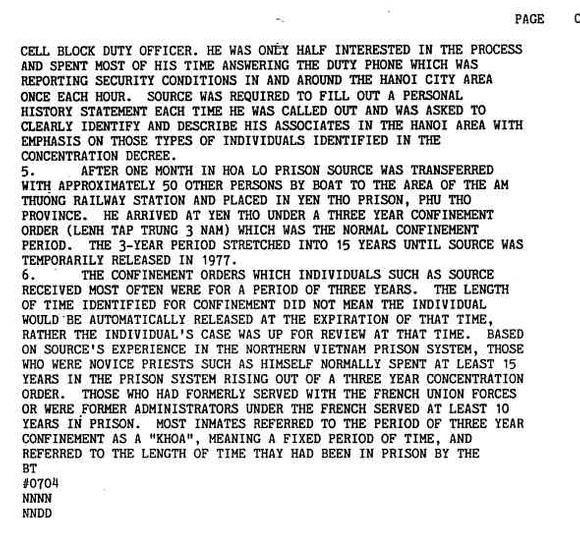
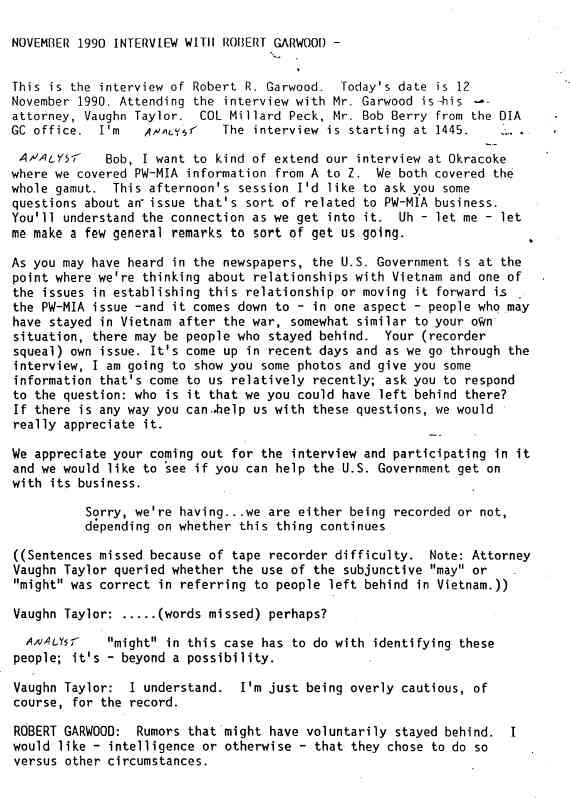
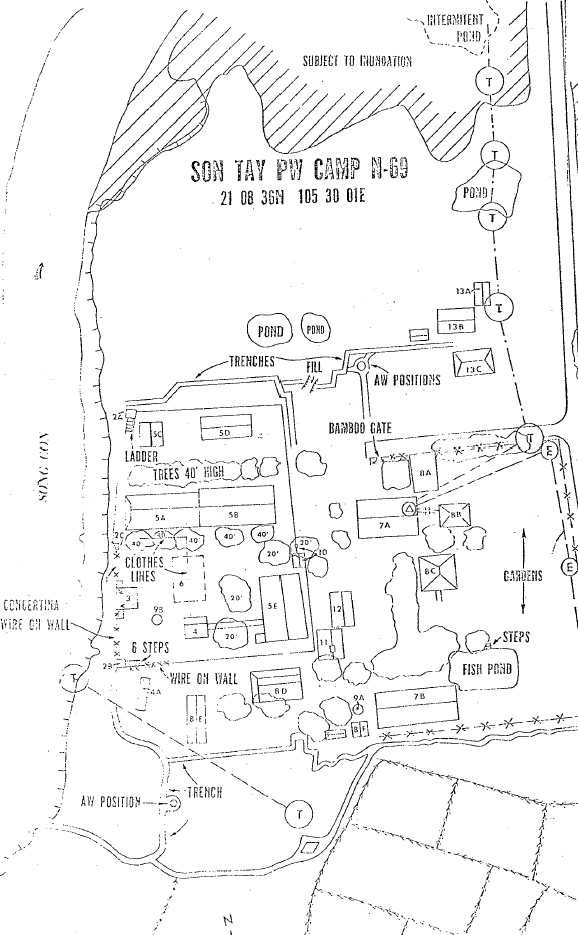
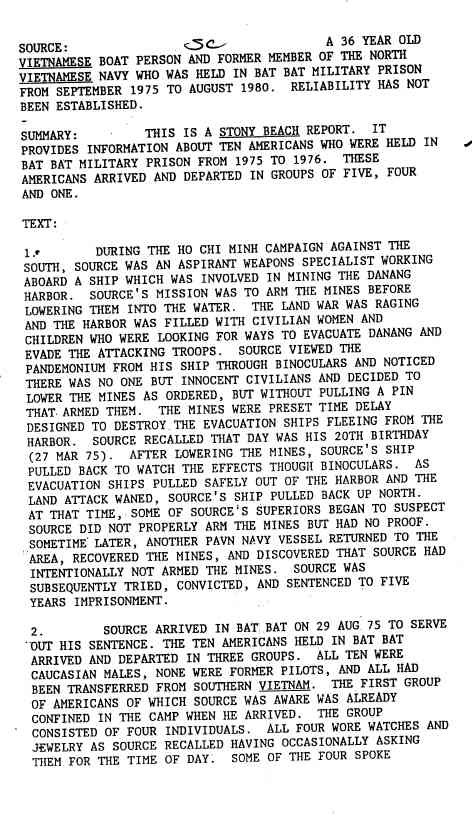
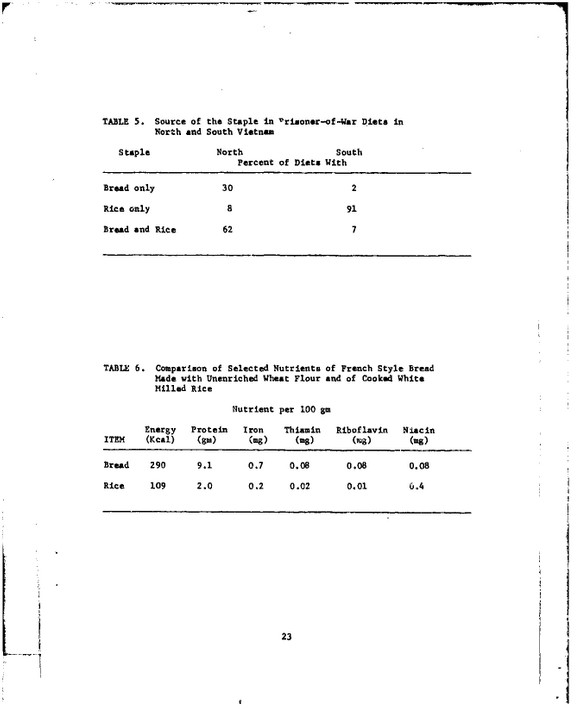
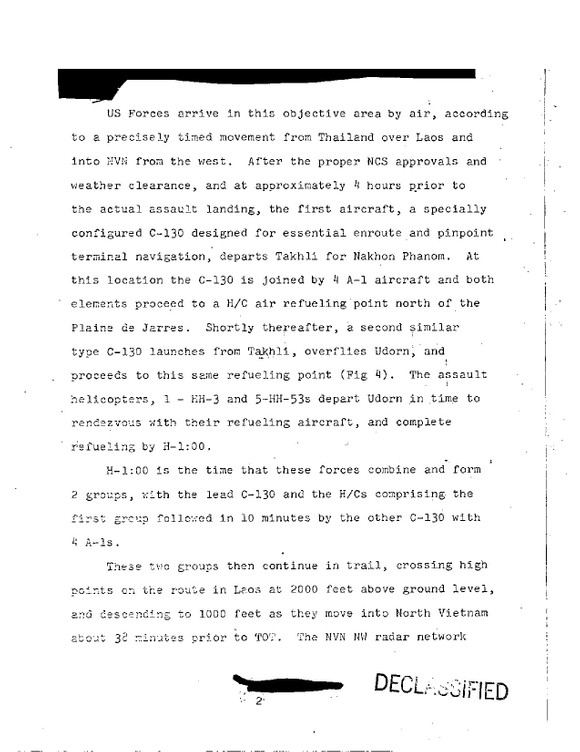
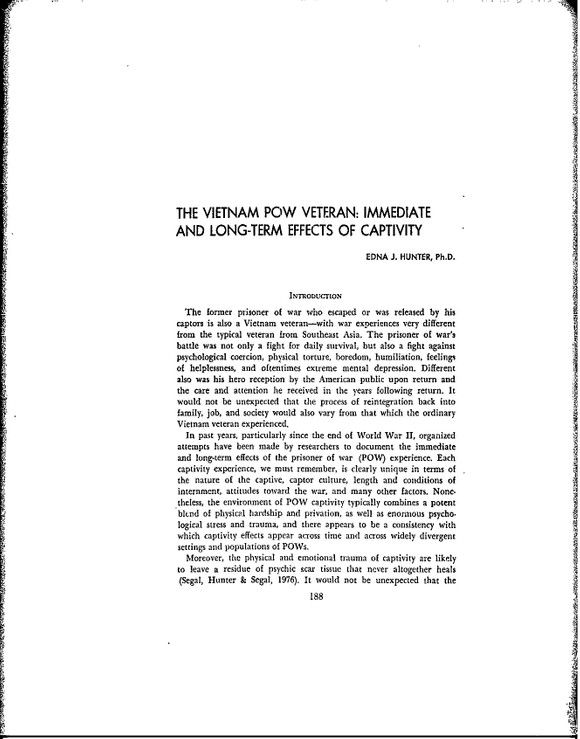
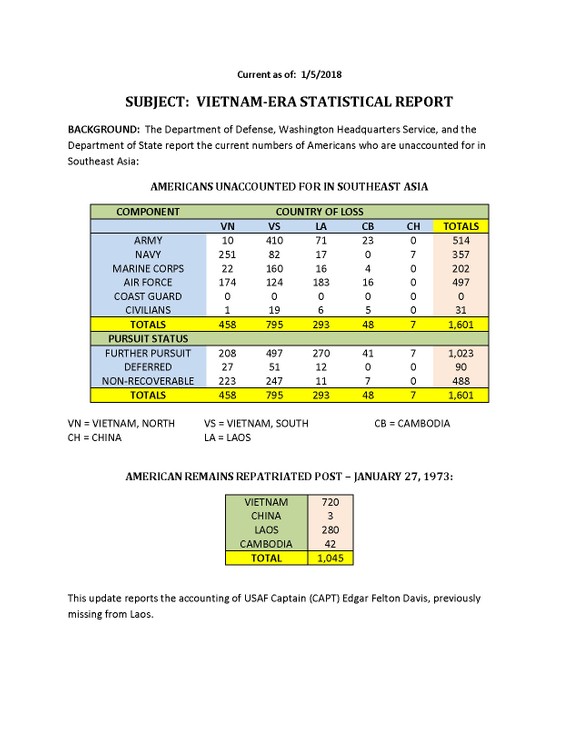
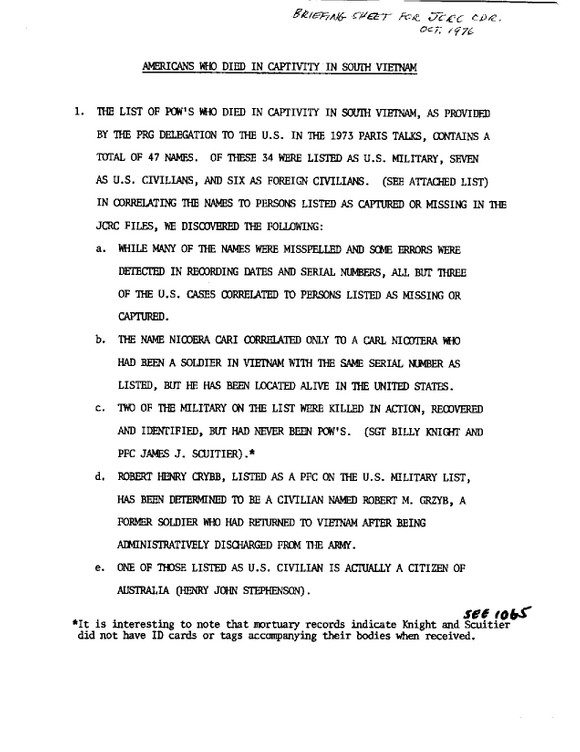
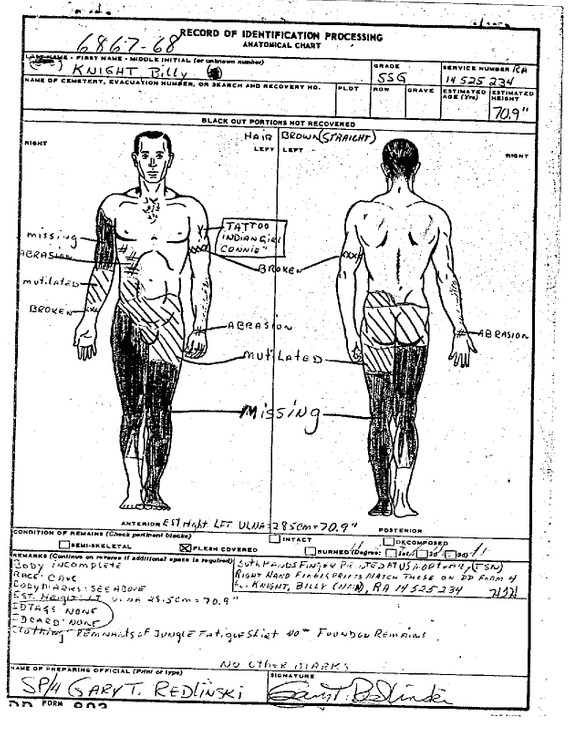
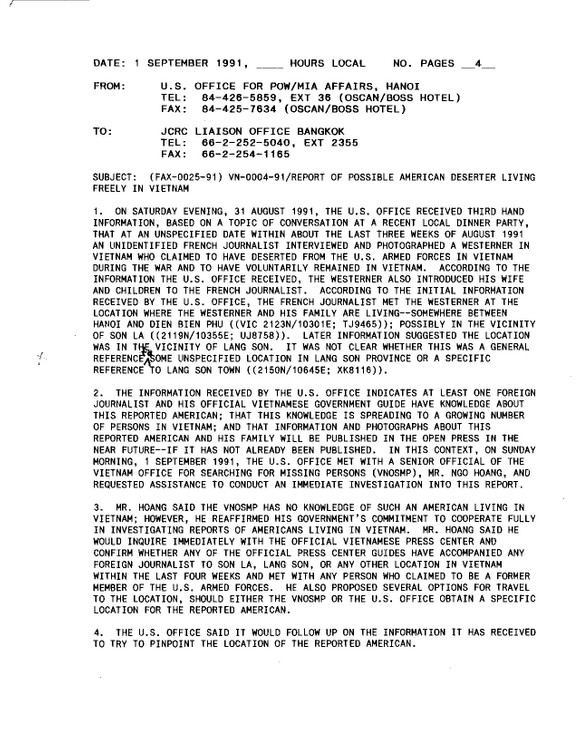
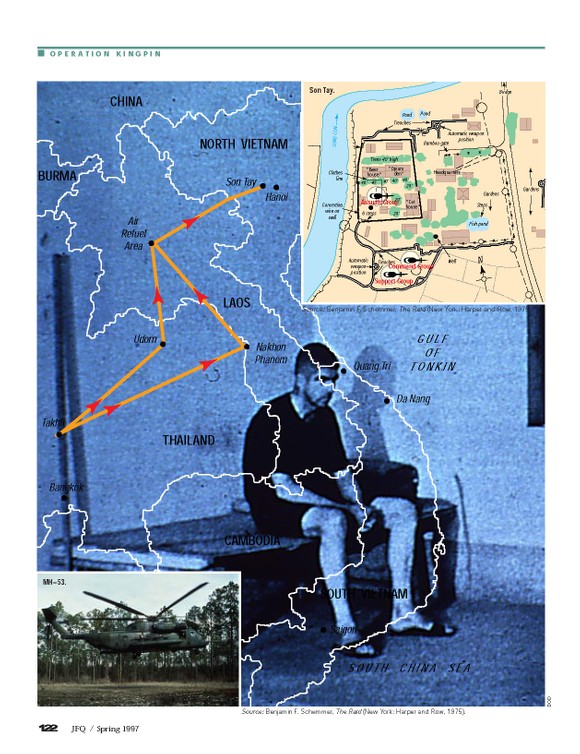


12,379 pages of Department of Defense files dealing with Southeast Asia POW/MIA issues stemming from the Vietnam War. Files date from 1965 to 2019.
Materials Include:
Department of Defense Vietnam War Statistical Reports 3/11/2014 to 2/22/2019
100 pages of reports from the Department of Defense, Washington Headquarters Service, and the Department of State report of the current numbers of Americans who are unaccounted for in Southeast Asia.
Defense Intelligence Agency (DIA) Stony Beach POW & POW Camp Files
2,716 pages of reports. Material dating from 1972 to 1994. The Defense Intelligence Agency (DIA), maintains a team based at Hickham Air Force Base in Hawaii, known as Stony Beach, dedicated solely to support the collection of POW/MIA intelligence, through human intelligence collection operations. Most of this information is gained via interviews throughout Southeast Asia. Stony Beach also performs live sighting investigations in Laos, Vietnam, and Cambodia. Files include: DIA reports from the early 1970's giving analysis, descriptions, locations, diagrams, maps, and handmade drawings concerning various POW camps. Includes DIA data sheets on individuals in Southeast Asia who have provided "live sighting" reports and information on human remains. DIA memorandums covering information obtained from other sources such as the CIA. Communications from the Joint Casualty resolution Center.
Among the many camps in which these files include intelligence on are: Son Tay, Bat Bat Prison, Xom Ap Lo PW Camp, Pho Lu Prison, Reeducation Camp 1 Hoang Lien Son Province, Ha Tay Reeducation Camp, Tra Noc Reeducation Camp, Ha Son Binh, Lai Xa Prison, Dan Hoi Barracks, Yen Bai Camp, Tan Lap Reeducation Camp, Thanh Phong Prison and Quyet Tien Prison.
Laos Prisoner of War Camp Study
A 1,457-page November 1972 Department of the Navy Fleet Intelligence Center Pacific report on the location of prisoner of war camps in Laos. Includes physical descriptions, coordinates of camps, and aerial reconnaissance photos (the mechanical reproductions of photos are minimally discernable).
Prisoners of War in Indochina RM 5729-1-ARPA
A January 1969 report, that was part of continuing Defense Department research into various military and political aspects of the termination of the Vietnam War. It was assumed that in the eventual settlement of the war, the question of the release and exchange of prisoners of war and civilian internees would be of major importance. This study examines issues that needed to be addressed to aid in the formulation of a policy regarding POW return.
Family Conferences - DOD Report of Conferences with Family of POW/MIA Servicemen
1,184 pages of reports of conferences with 269 family members of POW/MIA serviceman. Reports includes summary of information about each case provided to the family.
Barron 52 - Peters R. Cressman Case DOD Files
548 pages of files related to the Barron 52 - Peters R. Cressman Case. Sgt. Peter R. Cressman was the radio operator of Baron 52. Baron 52 was the call sign of a United States Air Force EC-47 carrying eight crew members that was shot down over Laos on 5 February 1973, a week after the Paris Peace Accords officially ended the United States involvement in the Vietnam War. The remains of four crewmen were recovered from the crash site, but those of the remaining four have never been found.
Family members and some POW/MIA advocates believe the four survived the crash and were taken captive and possibly sent to the USSR. Includes a Rebuttal Packet sent to the A.F.I.R.B. by the Cressman Family on 7 March 1994
Operation Kingpin: Son Tay Prisoner of War Rescue Operation
The collection contains a report written before the rescue attempt giving details of the plans of Operation Kingpin and two after action reports concerning the events of the operation.
On November 20-21, 1970, a joint force composed of United States Air Force Special Operations and rescue personnel and U.S. Army Special Forces, supported by U.S. Navy Carrier Task Force 77, made a daring raid on the Son Tay prison camp located less than 24 miles from Hanoi, North Vietnam. The objective was to rescue as many as 100 U.S. captives thought to be held there.
Reconnaissance flights by SR-71 Blackbirds discovered the POWs, and also pointed out that while the camp was only 23 miles northwest of Hanoi, the area was isolated and desolate. Conditions for the POWs were poor. Initial planning to rescue POWs was underway in June 1970. It was found that POWs of the camp were sending signals to help develop a rescue strategy, but Army Brig. Gen. Donald Blackburn, Special Assistant for Counterinsurgency and Special Activities, who worked directly for the Chairman of the Joint Chiefs of Staff, had an idea of his own. He decided that while the POWs suggestive signals of a rescue around Mount Ba Vi, where groups of POWs were often sent in working parties, would have a high chance for success, he thought an operation should be made to crash-land into the prison and rescue all the POWs rather than a few. During a briefing for Secretary of State Henry Kissinger before the raid, the last question he asked was "What if the raid fails?" He was told the raid stood a 95 to 97 percent chance of success as air crews had flown 697 hours, 268 sorties and the operation had been rehearsed 170 times.
The assault troops, in six ARRS helicopters accompanied by two C-130 aircraft, flew 400 miles to Son Tay from bases in Thailand. U.S. Navy pilots made a diversionary raid while USAF and Navy aircraft from seven air bases and three aircraft carriers flew refueling, surface-to-air
missile suppression, fighter cover, close air support, early warning, communications support and reconnaissance missions. Although no prisoners were found in the camp, the raid is considered a brilliant success in transporting, landing and recovering an assault force of 92
U.S. Air Force and 56 Army personnel, without the loss of a single man. The Son Tay Raid was described by Mike McKinney, co-author of the 2001 book, "Chariots of the Damned," as a special operations raid that "stands out above all as the best example of flawless planning, preparation and execution."
U.S. Prisoners of War DIA Memos
478 pages of Department of Defense Intelligence information report memos from 1972 to 1978, concerning American POWs.
Approximately 240 pages are discernable. Contains various information such as reports of sightings, aircraft shoot downs, and collaboration.
U.S. Prisoners of War Camps DIA Memos
236 pages of Department of Defense Intelligence information report memos from 1967 to 1968, concerning the possible location of Prisoner of War Camps in Vietnam, Cambodia, and Laos.
Approximately 170 pages are discernable. Contains intelligence information such as location, camp configuration, prisoner description, and security forces.
Abstract of Deposition of Honorable Richard T. Kennedy at POW/MIA Hearings
Transcript of Richard T. Kennedy's testimony before a closed hearing of the 1992 Select Committee on POW/MIA Affairs. In 1969 Kennedy joined the National Security Council as Director for National Security Council planning. His boss was Al Haig, who was Henry Kissinger's deputy. Richard Kennedy was Deputy Assistant to the President in the National Security Council staff from 1971 to 1975. His position allowed him to give valuable insight to the committee on the views of POW/MIA matters held by both the Nixon and Ford administrations.
Bo Gritz's Operation Lazarus
A set of well redacted Department of Defense memos containing a critique of the activities of former Green Beret Bo Gritz. Also included is a copy of Gritz's plan for his 1982 "Operation Lazurus," propertied by Gritz to be an attempt to rescue American POWs in Laos
Final Interagency Report of the Reagan Administration
19 pages of a report issued by the Reagan White House the day before President Reagan left office. President Ronald Reagan, in his address to the National League of Families of American Prisoners and Missing in Southeast Asia on July 29, 1988, announced that he had directed a comprehensive study of the POW/MIA issue be prepared.
The Case of PVT Robert R. Garwood, USMC
The Case of PVT Robert R. Garwood: Report to the Assistant Secretary of Defense for Command, Control, communication and intelligence (ASD/C3I). A June 1993 report on the investigation of Private Robert Garwood conducted by the Department of State, Defense Intelligence
Agency (DIA), United States Marine Corp (USMC), Department of Defense, and the Naval Investigative Service. PFC Robert R. Garwood disappeared from DaNang, South Vietnam in 1965. He was repatriated from the Socialist Republic of Vietnam in 1979. In 1981 he was convicted at court martial of collaboration with the enemy. In December of 1984, Garwood reported live sightings of American POWs in Vietnam. In June 1992 a government task force spent 30 days in Vietnam examining locations of Garwood's live sightings. Included are a final report, a deposition of Garwwod taken by U.S. Senate Select Committee on POW/MIA Affairs, Marine Corps Intelligence Debrief, Interview by Congressmen Lester L. Wolff and Benjamin A. Gilman and testimony before the Subcommittee on Asian and Pacific Affairs of the
U.S. House of Representatives.
Americans Unaccounted for in Indochina - Statistical Data
A 1989 stat sheet on for U.S. POW/MIA's and the U.S. position on live sightings.
U.S. Personnel and selected Foreign Nationals Missing, Southeast Asia 1993, 1995 & 1997
Defense Prisoner of War/Missing Personnel Office summary listings of
U.S. Personnel Missing in Southeast Asia and selected Foreign Nationals for the years 1993, 1995, and 1997. Reporting includes fields for file id number, name, current status, date individual was lost, branch of service, rank at time of loss, race, last known latitude/longitude of the individual's place of lost, country where individual was lost, vehicle identifier if a vehicle was connected with the loss, REFNO incidence reference number, time of incident, and return date of remains.
JANE FONDA: Repercussions of her 1972 Visit to North Vietnam (2010)
Jane Fonda visited North Vietnam in July 1972. Her actions during that infamous visit earned her the title “Hanoi Jane”.
Abstract: In Hanoi, Fonda also met with seven American POWs and later said they asked her to tell their friends and family to support presidential candidate George McGovern; they feared they'd never be freed during a Richard Nixon administration. Rumors spread and still persist that she betrayed them by accepting secret notes and then turning them over to the North Vietnamese. The POWs who were there have denied that this ever occurred.
Many feel she betrayed American troops and the United States; Vietnam veterans still despise the woman after nearly forty years. A factual historical account of her actions, words, and political alliances while in Hanoi provides insight to the strong emotional reactions that continue unabated. Her actions also exemplified the sometimes-narrow line between antiwar ideology and betrayal. Moreover, despite her stated intentions that she simply was an antiwar activist promoting peace, the ongoing debate continues if she committed treason by providing aid and comfort to the enemy.
A Historical Analysis of United States POW/MIA Repatriation and Remains Recovery (1998)
A 100-page study by MAJ Chandler C. Sherrell. This study investigates the historical record concerning the repatriation of American service members and the recovery of remains during World War II, Korea, and the Vietnam War. The issue of accounting for American service members has been proclaimed as a matter of the highest national priority and that the fullest possible accounting will be achieved.
In reality, the results of U.S. policy fall short of the stated intent. This paper focuses on evidence from the historical record that illustrates that less than a full accounting occurred.
Analysis of Live Sightings-Hearings before the Select Committee on POW-MIA Affairs August 4 and 5, 1992
Case Assessments (Cases 0011 to 1982)
An undated report of approximately 80 POW-MIA cases, with case numbers between 11 and 1982.
Joint Report From Department of Defense and Central Intelligence Agency (2000)
A Review of the 1998 National Intelligence Estimate on POW-MIA Issues and the Charges Levied by 'A Critical Assessment'
OTHER STUDIES INCLUDE:
A Summary of the 42-year Follow-up of Vietnam Prisoners of War: Mortality and Morbidity Findings
Injuries and Illnesses of Vietnam War POWS. I. Army POWs
Injuries and Illnesses of Vietnam War POWs Revisited: I. Navy Risk Factors
Injuries and Illnesses of Vietnam War POWs Revisited: III. Marine Corps Risk Factors
Injuries and Illnesses of Vietnam War POWs Revisited: IV. Air Force Risk Factors
Injuries and Illnesses of Vietnam War POWs Revisited: V. Combined Service Group Risk Factors
The Vietnam Pow Veteran: Immediate and Long-Term Effects Of Captivity
Families in Crisis: The Families of Prisoners of War
The Families of U.S. Navy Prisoners of War from Vietnam, Five Years After Reunion
Performance Of American POWs in the Vietnam War: Adequate Training or Creative Leadership?
Groupthink, Politics, and the Decision to Attempt the Son Tay Rescue
The Plight of American POW's in Korea and Vietnam
Psychological Dysfunction in Repatriated American Prisoners of War and its Relationship to Captivity and Demographic Variables
The Prisoners of War Experiences and Survival The American P.O.W. Experience
Nutrient Intake of the Repatriated United States Army, Navy and Marine Corps Prisoners-of-War of the Vietnam War
Project CHECO Southeast Asia Report Joint Personnel Recovery in Southeast Asia
U.S. Accounted-For from the Vietnam War Prisoners of War, Escapees, Returnees and Remains Recovered Reported for United States Air Force May 6, 2019
U.S. Accounted-For from the Vietnam War Prisoners of War, Escapees, Returnees and Remains Recovered Reported for United States Army May 6, 2019
U.S. Accounted-For from the Vietnam War Prisoners of War, Escapees, Returnees and Remains Recovered Reported for United States Marine Corps May 6, 2019
U.S. Accounted-For from the Vietnam War Prisoners of War, Escapees, Returnees and Remains Recovered Reported for United States Navy May 6, 2019
U.S. Accounted-For from the Vietnam War Prisoners of War, Escapees, Returnees and Remains Recovered Sorted by Name May 6. 2019
U.S. Accounted-For from the Vietnam War Prisoners of War, Escapees, Returnees and Remains Recovered Sorted by State May 6. 2019
U.S. Prisoners of War who escaped captivity during the Vietnam War Sorted by Name May 6. 2019
U.S. Un- Accounted-For from the Vietnam War Prisoners of War, Escapees, Returnees and Remains Recovered Sorted by Name May 6. 2019
U.S. Un- Accounted-For from the Vietnam War Prisoners of War, Escapees, Returnees and Remains Recovered Sorted by State May 6. 2019
U.S. Un-Accounted-For from the Vietnam War Prisoners of War, Escapees, Returnees and Remains Recovered Reported for United States Air Force May 6, 2019
U.S. Un-Accounted-For from the Vietnam War Prisoners of War, Escapees, Returnees and Remains Recovered Reported for United States Army May 6, 2019
U.S. Un-Accounted-For from the Vietnam War Prisoners of War, Escapees, Returnees and Remains Recovered Reported for United States Navy May 6, 2019














1 file (751.1MB)



